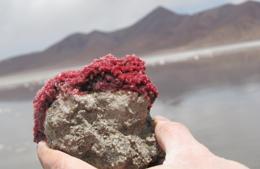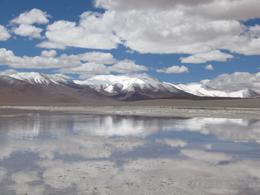In 2009, a team led by María Eugenia Farías, a microbiologist at the National Scientific and Technical Research Council in Tucumán, Argentina, discovered living stromatolites in the Socompa and Tolar Grande lagoons high in the Andes (see 'High window on the past'). Stromatolites - collections of photosynthetic microorganisms and calcareous concretions - are thought to have been common more than 3.5 billion years ago.
After that discovery, scientists in Argentina decided to look at lakes and lagoons in the Puna de Atacama, a desert plateau that sits more than 4,000 metres above sea level, in an attempt to understand what life might have looked like on the early Earth.
Lethal cocktail
But when in February 2010 they explored Laguna Diamante inside the still active Cerro Galán volcano - one of the world's largest volcanic caldera - they found microbes and flamingos flourishing in the extreme conditions rather than stromatolites.
Farías says that the lagoon is hyper alkaline (pH 11) and contains concentrations of salt five times higher than those of sea water. In addition, the concentration of arsenic in the water is 20,000 times higher than the level regarded as safe for drinking water by the US Environmental Protection Agency. Laguna del Diamante is located 4,600 metres above sea level, so any life also has to survive ultraviolet (UV) light that is around 40% more intense than in the lowlands as well as low oxygen concentrations, she adds. In addition, the volcano there is active and gaseous sulphur escaping from vents can make the environment even more hostile.

"To feed, flamingos filter saline water, retain nutrients and microorganisms and discard the fluids," explains Enrique Derlindati, a flamingo specialist at the National University of Salta in Argentina. "They are a very adaptable species that can live and adjust to diverse environments, but in this case Laguna del Diamante is very extreme."
Crystal conundrum
Investigators determined that the flamingos feed on the microorganisms in the microbial mats. So far, however, they have been unable to identify red crystals also found at the site. "These rocks are made of calcium carbonate associated with little red crystal reefs," says Farías. "But analysis with X-ray diffraction does not show any known or expected mineral."
In the hope of uncovering characteristics that could have medical or commercial applications, the investigators are working on genetically sequencing any bacteria, algae and fungi in the microbial mats. In other lagoons, in Puna and elsewhere, where there were less-extreme conditions, the team members have found antibiotic- and UV-resistant strains of bacteria, from which they isolated plasmids - extra-chromosomal DNA molecules - as well as enzymes that can function in extreme conditions. The researchers hope the hardy organisms will yield new antioxidants, compounds that filter UV light and enzymes that could be useful to the biotech industry or to molecular biologists.
Farías says that that the findings in Laguna del Diamante may also lead to clues on how life developed. "Low oxygen concentrations, high UV exposure and intense alkalinity, as found in this lagoon, are believed to be the hallmarks of archaic Earth," she says. "During our investigations at the Puna we found different new types of plasmids and biodiversity, and we are certain that Laguna del Diamante will house new findings to help us explain how life began on Earth".




Reader Comments
to our Newsletter